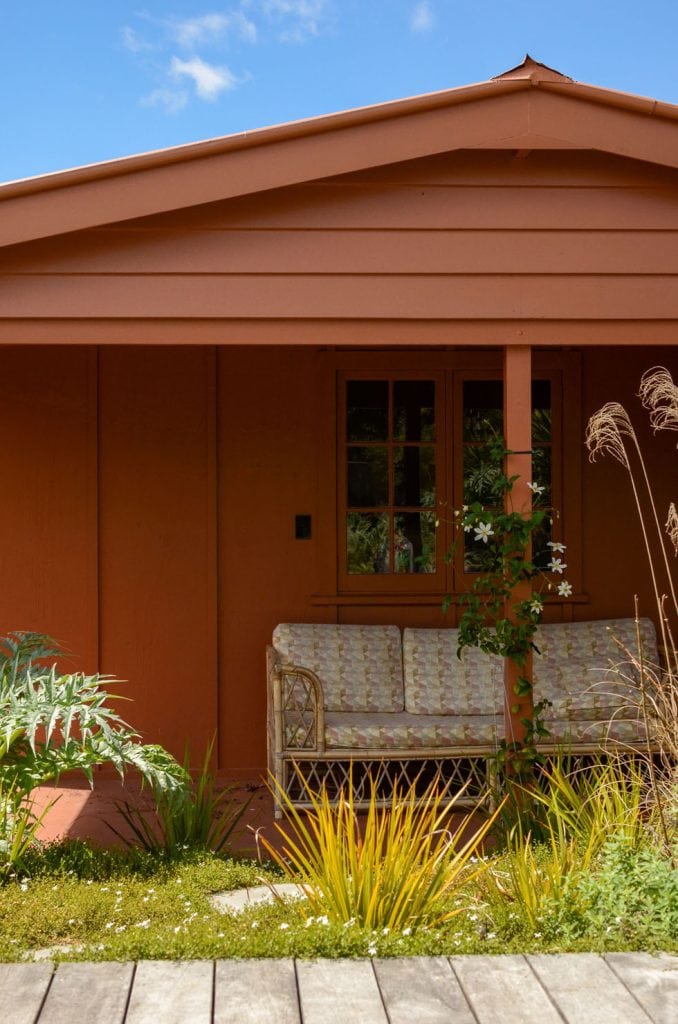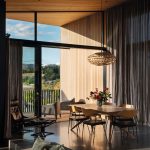Sitting back and letting nature take its course isn’t something many of us embrace. We prefer to control it, steering plants in a certain direction. Late-summer blooms get clipped back before they linger in their dried glory and typical hedge species are trimmed rather than allowed to grow loosely in their own way.
Encouraging plants to take their proper form aligns with patience and appreciation, which Tāmaki Makaurau/Auckland’s Kate Paterson seems to have plenty of. With that comes the blessing of surprise as her garden evolves with the seasons.


Seeking an immersive garden of contrasts brought about through unusually structured plants and striking flowers, Kate and her husband, architect Aaron Paterson of Pac Studio, asked landscape design studio Xanthe White Design to craft a scheme for the surroundings of the Mt Eden transitional villa they share with their sons Oscar (17) and Ira (14). Before the work commenced in conjunction with Worth Landscaping, the site was a patchwork of asphalt and lawn, and included steps leading into the house that weren’t conducive to Kate’s use of a wheelchair. In getting rid of that lawn, a blank canvas was created for natives and exotics to thrive side by side.


“I like the idea of having spaces defined by nature,” says Kate. “I suggested we go weird and wacky.” She also wanted the garden to be appreciated throughout the seasons. “Xanthe and her colleague James Sullivan have an amazing understanding of what plants do at different times of the year, so there’s always a lot of colour in our garden,” she says. Spring is when the verbena is at its best, and then, she says “we have massive cardoons in summer that grow to almost 2m high, with crazy purple flowers. Pink sedum comes up in autumn, and we planted Jerusalem sage, which is quite eccentric. It has yellow spears and amazing seed pods that go brown before the birds eat them and provides amazing structure during winter, which is also when the ornamental grass flowers. There’s always something to look forward to, and lots of up and down — a good balance.
“Corokia is such a cool, bizarre New Zealand native,” she continues. “It evolves uniquely and usually gets cut into a hedge, but we’re trying to let things be the form they are. Xanthe and James are into letting everything be as it is. We also have Joe Pye weed, which, when it dries, goes wispy, so we just leave it.”
James says that as well as designing to the light levels and site conditions, “one of the crucial parts of a good garden is having anchor points to hold it through the seasons. In winter, a lot of the perennials are down, but the shady parts of the garden are popping off, with native fuchsia groundcover and fern-like elements starting to become clear. Structural elements such as corokia and miscanthus stop it falling apart.”


Another part of Kate and Aaron’s brief was accessibility, so fluid forms characterise not only the plants but also the landscaping. At the back of the house, the team installed a deck that anchors the rear garden and sits flush with the home’s living area for smooth access. From here, a wide, sweeping path circles around the garden beds before returning to the deck.
“Often as a wheelchair user, you can look at a garden but you don’t get to be in it,” says Kate. “The idea was to make a garden that a person in a wheelchair can enter without constantly going up and down ramps. It’s great to come out and not have to go straight down a ramp.”


Xanthe says this garden is ultimately defined by this fluidity of movement. “It’s beautiful to see how by changing our perspective we’re able to unlock a new a language of space. The movement of a wheelchair has a circularity to it that has helped make this garden both a journey and truly immersive.”
Words Catherine Steel
Photography James Sullivan



